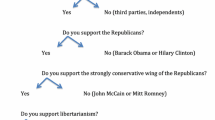Abstract
In the pragma-dialectical theory of argumentation fallacies are defined as violations of rules for critical discussion that further the resolution of differences of opinion on the merits. Viewed within this perspective, fallacies are wrong discussion moves. Such moves can occur in every stage of the resolution process and they can be made by both parties. Among the wrong moves that may occur in the argumentation stage are the fallacies of composition and division.
Access this chapter
Tax calculation will be finalised at checkout
Purchases are for personal use only
Similar content being viewed by others
Notes
- 1.
This contribution is based on an article by van Eemeren and Grootendorst (1999), which was recently republished as van Eemeren and Grootendorst (2009). We extended van Eemeren and Grootendorst’s approach by putting it in the newly-developed perspective of strategic manoeuvring (van Eemeren, to be published).
- 2.
In an argument scheme based on a symptomatic relation the starting point is that what is asserted in the standpoint is a symptom, expression or other sign of what is said in the argument or the other way around. See van Eemeren and Grootendorst (1992, 94–102, 158–168).
- 3.
Our distinction between unstructured wholes or non-ordered collections on the one hand and structured wholes on the other hand resembles Hamblin’s distinction between physical and functional collections (1970, 21).
- 4.
In connection with the non-transferability of properties of parts to wholes or the other way around, Woods and Walton speak of compositionally and divisionally hereditary properties respectively (1982, 206–207). For determining the transferability of properties they make use of Burge's theory of aggregates. See for an extensive exposition of this theory in relation to the composition and division fallacy Woods and Walton (1982).
- 5.
The same applies when instead of the average norm a functional norm is applied. If the property of being light is interpreted as ‘easy to carry’, a light agricultural machine is still heavy.
- 6.
The relative terms in the examples of composition and division fallacies are all the same not ambiguous in the ordinary linguistic sense. That is the reason why we do not regard them as fallacies of ambiguity. Textbooks in which a different approach is taken are Copi (1982, 124–128), Engel (1982, 93–95), and Rescher (1964, 76). Much earlier, Rowe (1962) argued already emphatically that these fallacies are not fallacies of ambiguity.
- 7.
An additional source of confusion is that there are cases in which the terms that are used to refer to a property are applicable both to the whole and the parts. Another complication in identifying the composition and division fallacy is that this fallacy can also be committed in combination with one or more other fallacies. See van Eemeren and Grootendorst (1992).
References
Copi, I. M. (1982). Introduction to logic (6th ed., 1st ed. 1953.). New York N.Y.: Macmillan.
Crawshay-Williams, R. (1957). Methods and criteria of reasoning. London: Routledge and Kegan Paul.
Engel, S. M. (1982). With good reason (2nd ed, 1st ed. 1976.). New York N.Y.: St. Martin’s Press.
Hamblin, C. L. (1970). Fallacies. London: Methuen & Co.
Jackson, S. (1995). Fallacies and heuristics. In F. H. van Eemeren, R. Grootendorst, J. A. Blair and C. A. Willard (Eds.), Analysis and Evaluation. Proceedings of the Third ISSA Conference on Argumentation, vol. II. (pp. 257–269). Amsterdam: Sic Sat.
Rescher, N. (1964) Introduction to logic. New York N.Y.: St Martin’s Press.
Rowe, W. L. (1962). The fallacy of composition. Mind, 71, 87–92.
van Eemeren, F. H., & Grootendorst, R. (1984). Speech acts in argumentative discussions. Dordrecht/Berlin: Foris/de Gruyter.
van Eemeren, F. H., & Grootendorst, R. (1992). Argumentation, communication, and fallacies. Mahwah N.J.: Lawrence Erlbaum.
van Eemeren, F. H., & Grootendorst, R. (1999). The fallacies of composition and division. In: J. Gerbrandy, M. Marx, M. de Rijke & I. Venema (Eds.), J.F.A.K.: Essays dedicated to Johan van Benthem on the occasion of his 50th birthday. Amsterdam: Amsterdam University Press, Vossius Press.
van Eemeren, F. H., & Grootendorst, R. (2009). The fallacies of composition and division. ALL (L’Analisi Linguistica e Letteraria).
van Eemeren, F. H., & Houtlosser, P. (2004). More about fallacies as derailments of strategic maneuvering: The case of tu quoque. In H. V. Hansen, Ch. W. Tindale, J. A. Blair, R. H. Johnson & R. C. Pinto (Eds.), Argumentation and its applications. Informal Logic @ 25. CD ROM ISBN 0-9683461-2-X-3-8.
van Eemeren, F. H., Grootendorst, R., Snoeck Henkemans, A. F., Blair, J. A., Johnson, R. H., Krabbe, E. C. W., et al. (1996). Fundamentals of argumentation theory. Mahwah N.J.: Lawrence Erlbaum.
Woods, J., & Walton, D. (1982). Argument: The logic of the fallacies. Toronto: McGraw-Hill Ryerson.
Author information
Authors and Affiliations
Corresponding author
Rights and permissions
Copyright information
© 2015 Springer International Publishing Switzerland
About this chapter
Cite this chapter
van Eemeren, F.H., Garssen, B. (2015). Linguistic Criteria for Judging Composition and Division Fallacies. In: Reasonableness and Effectiveness in Argumentative Discourse. Argumentation Library, vol 27. Springer, Cham. https://doi.org/10.1007/978-3-319-20955-5_31
Download citation
DOI: https://doi.org/10.1007/978-3-319-20955-5_31
Published:
Publisher Name: Springer, Cham
Print ISBN: 978-3-319-20954-8
Online ISBN: 978-3-319-20955-5
eBook Packages: Humanities, Social Sciences and LawPhilosophy and Religion (R0)




